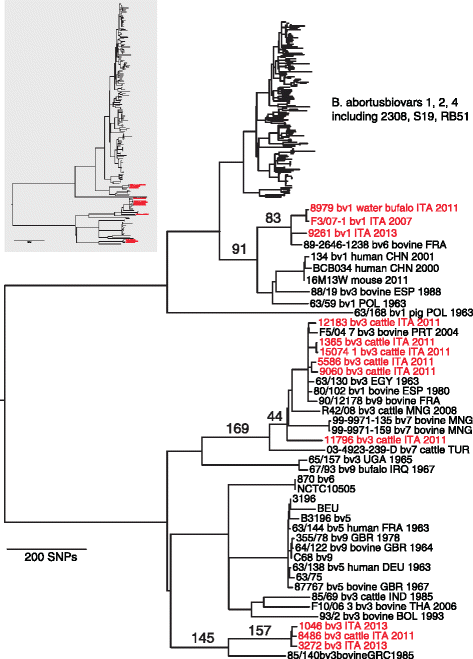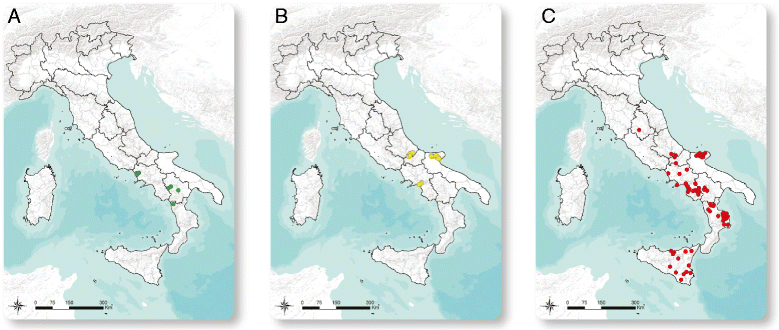Origins and global context of Brucella abortus in Italy
- PMID: 28152976
- PMCID: PMC5290641
- DOI: 10.1186/s12866-017-0939-0
Origins and global context of Brucella abortus in Italy
Abstract
Background: Brucellosis is a common and chronic disease of cattle and other bovids that often causes reproductive disorders. Natural infection in cattle is caused by Brucella abortus and transmission typically occurs during abortions, calving, or nursing. Brucellosis is also a major zoonotic disease due to contamination of dairy products or contact with the tissues of infected animals. Brucellosis has been eradicated from most of the developed world in the last 40 years but persists in many regions-the disease remains prevalent in portions of Africa, the Middle East, Asia, and Central and South America, as well as in the Mediterranean basin. In Italy, B. abortus has persisted in southern regions in both cattle and water buffalo. Previous attempts at analyzing the phylogenetics of B. abortus in Italy have been challenging due to limited genetic variability and unresolved global population genetic structure of this pathogen.
Results: We conducted genome-wide phylogenetic analyses on 11 representative strains of B. abortus from Italy, and compared these sequences to a worldwide collection of publically available genomes. Italian isolates belong to three clades that are basal to the main and global B. abortus lineage. Using six SNP-based assays designed to identify substructure within the Italian clades, we surveyed a collection of 261 isolates and found that one clade predominates throughout endemic districts in the country, while the other two clades are more geographically restricted to portions of southern Italy.
Conclusions: Although related strains exist worldwide, B. abortus isolates from Italy are substantially different than those found in much of the rest of Europe and North America, and are more closely related to strains from the Middle East and Asia. Our assays targeting genetic substructure within Italy allowed us to identify the major lineages quickly and inexpensively, without having to generate whole genome sequences for a large isolate collection. These findings highlight the importance of genetic studies to assess the status and the history of pathogens.
Figures


References
-
- EFSA (European Food Safety Authority) ECDC (European Centre forDisease Prevention and Control) The European Union summary report on trends and sources of zoonoses, zoonotic agents and food-borne outbreaks in 2014. EFSA J. 2015;13(12):4329.
-
- Alton GG, Forsyth JRL. Brucella. In: Galveston SB, editor. Medical Microbiology. Fourth. Texas: University of Texas Medical Branch; 1996. pp. 137–146. - PubMed
-
- Bang B. The etiology of epizootic abortion. J Comp Pathol Ther. 1897;10:125IN122–149. doi: 10.1016/S0368-1742(97)80014-8. - DOI
-
- Meyer KF, Shaw EB. A comparison of the morphologic, cultural and biochemical characteristics of B. abortus and B. melitensis* studies on the genus Brucella nov. gen. I. J Infect Dis. 1920;27(3):173–184. doi: 10.1093/infdis/27.3.173. - DOI
-
- Godfroid J, Cloeckaert A, Liautard J-P, Kohler S, Fretin D, Walravens K, Garin-Bastuji B, Letesson J-J. From the discovery of the Malta fever’s agent to the discovery of a marine mammal reservoir, brucellosis has continuously been a re-emerging zoonosis. Vet Res. 2005;36:313–326. doi: 10.1051/vetres:2005003. - DOI - PubMed
MeSH terms
Substances
LinkOut - more resources
Full Text Sources
Other Literature Sources

